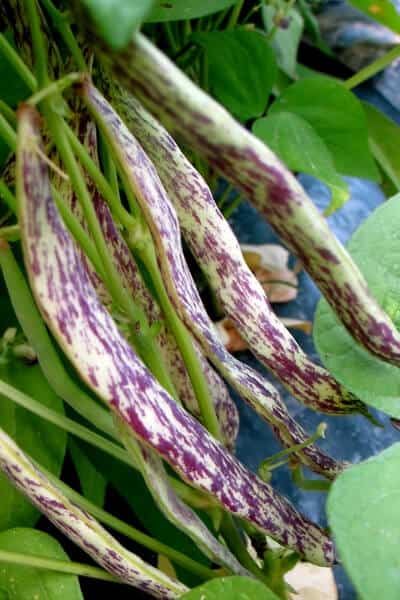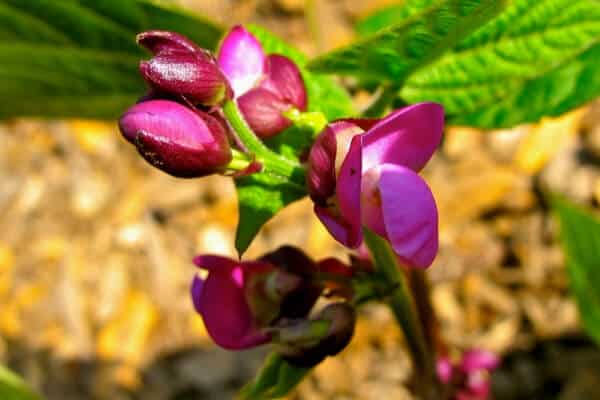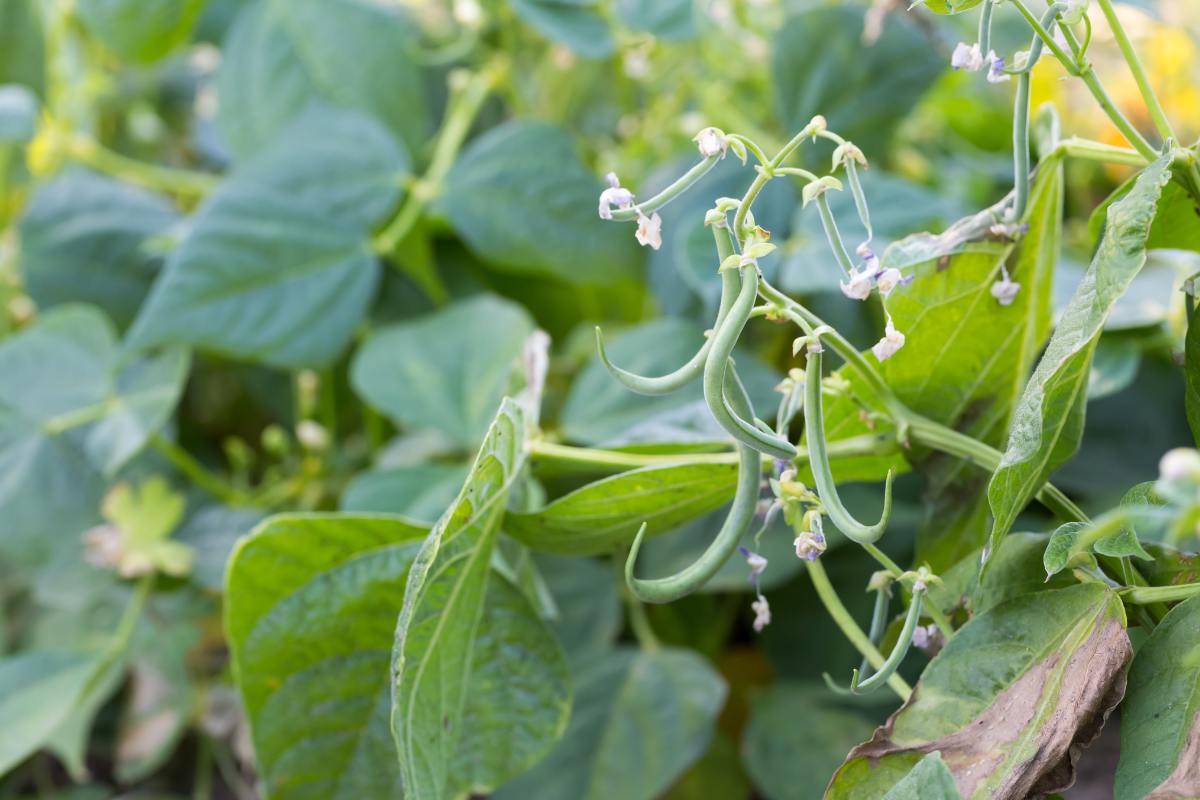In this article: Growing green beans in the garden is simple. Learn all about how to grow beans from seed to harvest!
I love growing green beans. Actually- I love growing all beans, and most of the varieties I grow aren’t even green!
This site contains affiliate links. If you make a purchase using one of these links, I may earn a commission. Please see my disclosure page for more information about cookies collected and our privacy policy.
Green beans are an easy crop, great for beginners and if you are gardening with kids.
Bean seeds germinate easily and grow quickly. And if you’ve never eaten a raw bean straight from the vine, you are missing out!
How to Grow Beans in Your Backyard Vegetable Garden
Green beans are in the legume plant family along with peas, peanuts, dry beans, and soybeans.
They are a great calorie crop that is packed with fiber, protein, calcium and other vitamins. It’s a must in any garden.
When (and How) to Plant Green Beans
Green beans (or string beans) are sowed directly outside after the danger of frost has passed. They can be started indoors, but since they germinate readily there’s really no need and you run the risk of killing the plant at transplanting.
Plant the seeds about 1 inch deep in fertile, well drained soil.
Keep the soil evenly moist while the seeds are germinating.
Your seeds should germinate in 7-10 days, though if the soil temperatures are still quite cool, they may take longer.
Bean Varieties to Grow
There are 2 general types of beans grown in the backyard garden:
Bush Beans: The bush type beans are more compact in their growth. The plants only get a couple of feet tall. They do not require any support while growing. Bush beans tend to produce all of their beans at one time (over a 3-4 week period) Making them a great choice if you want to preserve a lot at once. I personally prefer the taste of bush beans.
Pole Beans: Pole beans are longer, vining beans. They can grow more than 10 ft in length. If you are growing pole beans you will need to provide support such as a fence, string, or even another crop like corn or sunflowers. Pole beans have a longer harvest period with 6-8 weeks of picking.
Below are some of my favorite bean varieties to grow:
Dragon Tongue Bush Beans: These are my very favorite bean to grow. They are beautiful- whitish-yellow with purple streaks. The plants give great yields of 7 inch pods, and the taste can’t be beat. 60 days to harvest.
Golden Wax Beans: You can’t go wrong with golden wax beans. Golden Wax beans grow about 15 inches tall and produce delicious golden pods that are about 5-6″ long. Rich and buttery in flavor. This variety is resistant to rust. 52 days to harvest.
Calima Green Beans: This is a french bean, that is great for fresh eating, steaming, and sauteing, but can also be preserved. Upright, bush plant are full of easy-to-pick pods. Harvest when they are no wider than a pencil. Approximately 50 days to harvest.
Blue Lake Bush Beans: One of the most popular varieties. One of the best for preserving either by canning or freezing. Reliable, disease resistant, and huge yields. 55 days to harvest.
Kentucky Wonder Pole Bean: This is a classic pole bean variety that never goes out of style. It is a heavy producer of 8-10 inch pods. Will produce over an extended season. 60-70 days to harvest.
Purple Podded Pole Beans: This is one of my favorite pole bean varieties. The vines grow about 6 ft tall and give good yields of tender purple beans.
Chinese Long Beans: If you want to try something new and different, Chinese long beans fit the bill! They can grow more than 20 inches in length! They are a climbing and vining variety that comes in green or purple varieties. Pick them young for the best texture and flavor.
Tips for Growing the Best Beans
Beans prefer full sun. Plant them in a space that gets a least 6-8 hours of sun per day.
While the plants are young, water frequently so they do not dry out. You can use mulch to preserve water and reduce weeds. Water the base of the plants as opposed from above.
Give your beans enough space. Overcrowding can cause a lot of problems in the garden. Plant your bean seeds about 4 inches apart. I usually do double rows spaced close together with each set of double rows being about 18 inches apart.
If growing bush bean plants, make successive plantings every couple of weeks to prevent the beans from ripening all at one time and extend your season.
Beans are easy to grow– pretty much drop a seed in the soil and wait. But they can have problems with some pests and disease.
Mexican bean beetles like to eat the leaves, flowers, and beans. These beetles look like yellow-orange lady bugs and the larva is soft, yellow, and spiny. Try companion planting with marigold, nasturtium or potatoes to help control bean beetles.
Peppermint and rosemary essential oil can also help deter this pest.
Beans can also be susceptible to mosaic viruses. This can cause yellowing, stunted growth, and other deformities. Proper spacing and air circulation can help prevent mosaic viruses as can controlling aphids in the garden.
Beans may also be plagued by rust. This fungal disease occurs most often in prolonged times of warm, wet weather and causes red-orange spots on the leaves of your plants. Watering from below, on sunny days, and proper spacing can help keep your plants healthier. You can also try using essential oils in the garden to treat fungal infections.
Pole bean and other climbing varieties need support to grow. You can use a fencing panel, bamboo teepee, or string.
Making a bean teepee is a favorite garden activity for kids and gives them a fun shaded, bean fort to play in while in the garden.
When to Harvest Green Beans
Green beans are ready to be harvested when are about the width of a pencil for round varieties. Beans should be firm and able to be snapped.
Young beans are more tender and have better flavor. If you can see beans forming inside the pods, your beans might be too mature and be more tough in texture.
Beans don’t require a very long growing season. How long it will take your green beans to reach maturity will depend on type, but the averages are as follows:
Pole Beans: 60-65 days to maturity
Bush Beans: 50-55 days to maturity
To pick beans, snap the stems or cut the beans off the plant. The bean plant stems can break quite easily so be careful not to just pull on the beans.
It’s also best to pick when the plants are dry, so on sunny days after the dew has dried.
Harvest your beans daily to keep the bean plants producing more and more.
What can you do with your bean harvest?
- Eat them fresh from the plant (yum!)
- Store them in the fridge for up to 4 days and eat with meals
- Pickled them
- Pressure can them
- Blanch and freeze them
Here’s my full guide on all the ways you can preserve green beans from the garden!
Check Out More Growing Guides:







